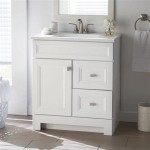Bathroom Sink Faucets: A Comprehensive Guide to Selection and Installation
Bathroom sink faucets are more than just functional components; they are integral to the bathroom's aesthetic and contribute significantly to the overall user experience. Selecting the right faucet involves considering a variety of factors, including style, functionality, material, and installation requirements. This article provides a comprehensive overview of bathroom sink faucets, covering the different types available, key features to consider, and essential installation guidelines.
The market offers a diverse array of bathroom sink faucets designed to accommodate various plumbing configurations and design preferences. Careful consideration should be given to the existing plumbing setup to ensure compatibility and ease of installation. The faucet's design should complement the sink and the overall bathroom decor, creating a cohesive and visually appealing space.
Understanding Different Types of Bathroom Sink Faucets
Bathroom sink faucets are categorized based on their mounting style, handle configuration, and spout design. Understanding these categories is crucial for making an informed selection that aligns with your specific needs and preferences.
Centerset Faucets: These faucets are designed for sinks with three pre-drilled holes, typically spaced four inches apart. The handles and spout are integrated into a single unit, making them a compact and convenient option for smaller sinks or bathrooms. Centerset faucets are widely available in a variety of styles, from traditional to contemporary, ensuring a match for different design aesthetics.
Single-Hole Faucets: As the name suggests, single-hole faucets require only one hole in the sink or countertop for installation. These faucets often feature a single handle that controls both water temperature and flow. Their minimalist design makes them a popular choice for modern bathrooms, contributing to a clean and uncluttered look. Some single-hole faucets may include a deck plate to cover existing holes if replacing a centerset faucet.
Widespread Faucets: Widespread faucets are designed for sinks with three pre-drilled holes spaced eight inches or more apart. The handles and spout are separate units, allowing for greater design flexibility and customization. Widespread faucets are often favored for larger sinks and vanities, providing a more visually substantial presence. They are available in a variety of styles, from traditional to contemporary, and offer numerous handle and spout options.
Vessel Faucets: Vessel faucets are specifically designed for use with vessel sinks, which sit above the countertop. These faucets are typically taller than standard faucets to accommodate the height of the vessel sink. They can be either single-hole or widespread, depending on the sink's design and the desired aesthetic. Vessel faucets are often characterized by their sleek and modern designs, complementing the unique look of vessel sinks.
Wall-Mounted Faucets: Wall-mounted faucets are installed directly into the wall behind the sink, creating a clean and minimalist look. These faucets require careful planning and installation, as the plumbing must be routed through the wall. Wall-mounted faucets are a popular choice for modern bathrooms, freeing up countertop space and providing a unique design element. They are available in a variety of styles and finishes, allowing for customization to match the bathroom's decor.
Key Features and Considerations When Selecting a Bathroom Sink Faucet
Beyond the mounting style, several other factors should be considered when selecting a bathroom sink faucet to ensure optimal performance and satisfaction. These features include the faucet's material, finish, valve type, and water efficiency.
Material: The material of the faucet significantly impacts its durability, longevity, and resistance to corrosion. Common materials used in bathroom sink faucets include:
Brass: Brass is a durable and corrosion-resistant material that is widely used in faucet construction. It is often used as the base material for faucets, providing a solid and reliable foundation. Brass faucets are known for their longevity and ability to withstand the rigors of daily use.
Stainless Steel: Stainless steel is another popular choice for faucets due to its durability, corrosion resistance, and sleek appearance. Stainless steel faucets are relatively easy to clean and maintain, making them a practical choice for busy bathrooms. They offer a modern and contemporary look that complements various design styles.
Zinc Alloy: Zinc alloy is a less expensive option compared to brass and stainless steel. While it can be durable, it is generally not as resistant to corrosion as the other two materials. Zinc alloy faucets are often plated with other finishes to enhance their appearance and durability.
Finish: The finish of the faucet not only contributes to its aesthetic appeal but also affects its resistance to scratches, stains, and corrosion. Common faucet finishes include:
Chrome: Chrome is a classic and versatile finish that is known for its durability and easy maintenance. Chrome faucets are highly reflective, providing a bright and clean look. They are also relatively scratch-resistant and easy to clean.
Brushed Nickel: Brushed nickel offers a warm and understated alternative to chrome. Its matte finish helps to conceal water spots and fingerprints, making it a practical choice for busy bathrooms. Brushed nickel faucets have a subtle texture that adds visual interest.
Oil-Rubbed Bronze: Oil-rubbed bronze is a darker finish that evokes a traditional and rustic aesthetic. It is often used in bathrooms with a vintage or farmhouse style. Oil-rubbed bronze faucets have a unique patina that deepens over time.
Matte Black: Matte black is a contemporary finish that adds a touch of sophistication to any bathroom. It is a popular choice for modern and minimalist designs. Matte black faucets provide a bold contrast against lighter-colored sinks and countertops.
Valve Type: The valve type determines how the faucet controls water flow and temperature. Common valve types include:
Compression Valves: Compression valves are the oldest type of faucet valve. They use rubber washers that compress against the valve seat to stop the flow of water. Compression valves are prone to leaks and require more maintenance than other valve types.
Ball Valves: Ball valves use a ball with holes that rotate to control water flow and temperature. They are more durable and reliable than compression valves but can still be prone to leaks over time.
Cartridge Valves: Cartridge valves use a sealed cartridge with internal discs or cylinders to control water flow and temperature. They are more durable and reliable than ball valves and are less prone to leaks. Cartridge valves are relatively easy to repair or replace.
Ceramic Disc Valves: Ceramic disc valves are the most durable and reliable type of faucet valve. They use two ceramic discs that slide over each other to control water flow and temperature. Ceramic disc valves are virtually leak-proof and require minimal maintenance.
Water Efficiency: Water-efficient faucets can help conserve water and reduce water bills. Look for faucets with a WaterSense label, which indicates that they meet the Environmental Protection Agency's (EPA) criteria for water efficiency. WaterSense-labeled faucets use a maximum of 1.5 gallons per minute (GPM) without sacrificing performance.
Essential Installation Guidelines for Bathroom Sink Faucets
Proper installation is crucial for ensuring the faucet's functionality and preventing leaks. While professional installation is recommended, particularly for complex plumbing configurations, many homeowners can successfully install a bathroom sink faucet themselves by following these guidelines.
Preparation: Begin by turning off the water supply to the sink. This is typically done by closing the shut-off valves located under the sink. Place a bucket under the sink to catch any residual water. Gather the necessary tools, including an adjustable wrench, basin wrench, plumber's tape, and screwdriver.
Removal of Old Faucet: Disconnect the water supply lines from the old faucet. Use a basin wrench to loosen and remove the mounting nuts that secure the faucet to the sink. Carefully lift the old faucet out of the sink.
Cleaning the Sink: Clean the sink surface thoroughly to remove any debris or residue from the old faucet. This will ensure a proper seal for the new faucet.
Installing the New Faucet: Apply plumber's tape to the threads of the faucet's water supply connections. Insert the faucet into the sink holes, ensuring that it is properly aligned. Secure the faucet to the sink using the mounting hardware provided with the new faucet.
Connecting the Water Supply Lines: Connect the water supply lines to the faucet's water inlets. Tighten the connections securely, but avoid over-tightening, which can damage the fittings.
Checking for Leaks: Turn on the water supply and check for leaks around the faucet and water supply connections. If leaks are present, tighten the connections further or re-apply plumber's tape.
Testing the Faucet: Test the faucet to ensure that it is functioning properly. Check the water flow and temperature adjustment. Observe the faucet for any drips or leaks.
By carefully considering the various types of bathroom sink faucets, key features, and installation guidelines, homeowners can make informed decisions that enhance the functionality and aesthetics of their bathrooms. Proper selection and installation ensure long-lasting performance and a satisfying user experience.

Bathroom Faucets Showers Toilets And Accessories Delta Faucet

Faucet

Modern Bathroom Sink Faucets Isenberg
Bathroom Faucets Kingston Brass

6 Best Brands Of Luxury Bathroom Faucets An Expert Ysis

Which Faucet Goes With Sink

Adam Bathroom Sink Faucet Mixer Deck Mounted Single Hole Signature Faucets

Modern Contemporary Bathroom Kitchen Plumbing Fixtures

Bathroom Sink Faucet With Water Fountain Pull Out Sprayer Nmc Decor

Kastel Basin Faucets Modern Bathroom Mixer Tap Single Handle Hole Crane Signature
Related Posts







